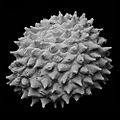Acritarch facts for kids
Acritarchs are early microfossils, the remains, probably, of eukaryote cells. It is the resistant single-layered cell walls, or perhaps a cover secreted by cell walls, that we see in early rocks of the Proterozoic era. These structures are organic in their chemical composition, not calcium carbonate. Their precise nature is not known, but they look like the resting stages of modern dinoflagellates (the 'red tide' organisms).
- "These microfossils represent the resting stage in the reproductive cycle of eukaryote algae".p258
Acritarchs appear in quantity in organic-rich shales and siltstone strata 1.4 to 1.6 billion years old.p57 They include a wide range of forms, so it is not clear whether or not they are monophyletic. At about 1 billion years ago they started to increase in abundance, diversity, and especially size and number of spines. Their populations crashed during the Cryogenian period 860 million years ago (the Snowball Earth episodes). They proliferated in the Cambrian explosion and reached their highest diversity in the Palaeozoic. They survived at least until the Ordovician period.p256
The increased spininess possibly resulted from the need for defence against predators large enough to swallow them or tear them apart. Other groups of small organisms from the Neoproterozoic era also show signs of anti-predator defences.
Recent discovery
A recent discovery has greatly extended our knowledge of acritarchs. Large (50μm) acritarchs have been found in silica-based rocks of Archaean age in South Africa. These rocks date to 3,200 million years ago, which makes them the second oldest life to be found as fossils. The earliest are cyanobacteria found in stromatolites.
The significance of this is that acritarchs are eukaryotes. This means that eukaryotes were present at least 1.5 billion years earlier than had been supposed.
Images for kids
See also
 In Spanish: Acritarco para niños
In Spanish: Acritarco para niños


